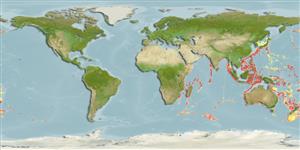Classification / Names
Common names | Synonyms | Catalog of Fishes(genus, species) | ITIS | CoL | WoRMS | Cloffa
Teleostei (teleosts) >
Ophidiiformes (Cusk eels) >
Bythitidae (Livebearing brotulas)
Etymology: Pseudonus: Greek, pseudes = false + Greek, onos = hake.
Environment: milieu / climate zone / depth range / distribution range
Ecology
Marine; bathydemersal; depth range 416 - 1270 m (Ref. 86869). Deep-water
Indo-West Pacific: Gulf of Aden, Philippines and south of Taiwan and off Northwest Australia.
Size / Weight / Age
Maturity: Lm ? range ? - ? cm
Max length : 11.6 cm SL male/unsexed; (Ref. 86869)
Dorsal soft rays (total): 95 - 102; Anal soft rays: 64 - 71; Vertebrae: 55 - 59. This species is distinguished by the following characters: D 95-102; A 64-71; vertebrae 55-59; pelvic fin with one ray each (with one specimen having no pelvic fin ray) (Ref. 86869).
Rare species, found on soft bottom (Ref. 34024).
Life cycle and mating behavior
Maturities | Reproduction | Spawnings | Egg(s) | Fecundities | Larvae
Nielsen, J.G., D.M. Cohen, D.F. Markle and C.R. Robins, 1999. Ophidiiform fishes of the world (Order Ophidiiformes). An annotated and illustrated catalogue of pearlfishes, cusk-eels, brotulas and other ophidiiform fishes known to date. FAO Fish. Synop. 125(18):178p. Rome: FAO. (Ref. 34024)
IUCN Red List Status (Ref. 130435)
Threat to humans
Harmless
Human uses
Fisheries: of no interest
Tools
Special reports
Download XML
Internet sources
Estimates based on models
Preferred temperature (Ref.
123201): 2.1 - 9.6, mean 7.1 °C (based on 418 cells).
Phylogenetic diversity index (Ref.
82804): PD
50 = 0.7500 [Uniqueness, from 0.5 = low to 2.0 = high].
Bayesian length-weight: a=0.01000 (0.00244 - 0.04107), b=3.04 (2.81 - 3.27), in cm total length, based on all LWR estimates for this body shape (Ref.
93245).
Trophic level (Ref.
69278): 3.4 ±0.5 se; based on size and trophs of closest relatives
Resilience (Ref.
120179): High, minimum population doubling time less than 15 months (Preliminary K or Fecundity.).
Fishing Vulnerability (Ref.
59153): Low vulnerability (10 of 100).
